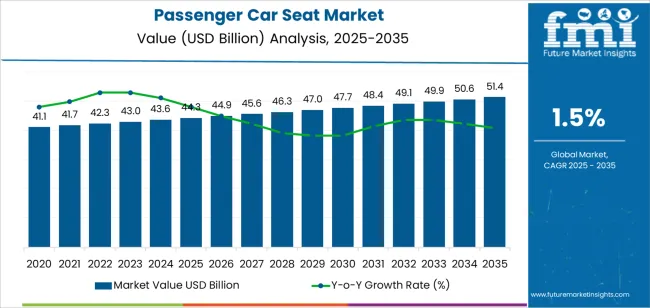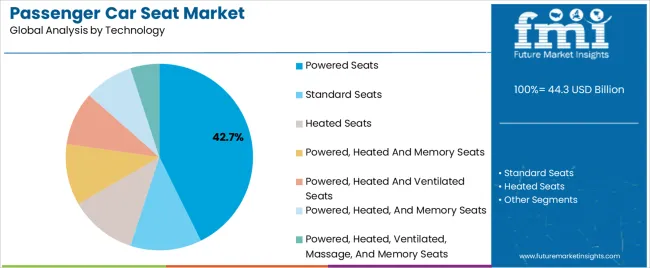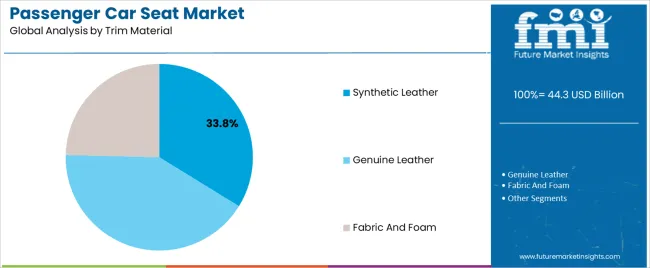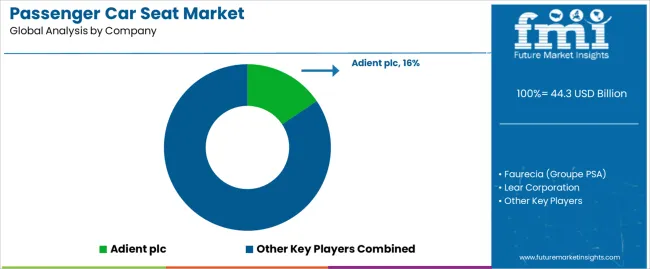The passenger car seat market is expanding steadily, fueled by rising vehicle production, growing consumer preference for comfort-oriented interiors, and technological advancements in seating systems. Increasing demand for ergonomic design, premium materials, and smart adjustment features has encouraged automakers to invest in advanced seating solutions.
The integration of lightweight materials and modular structures contributes to improved fuel efficiency and reduced emissions. Additionally, the shift toward electric and autonomous vehicles is driving innovation in flexible and adaptive seating layouts.
The market outlook remains strong as manufacturers prioritize safety, comfort, and aesthetic differentiation to enhance overall driving experience. With expanding adoption of powered and ventilated seating systems, the passenger car seat market is positioned for continuous growth in the coming years.

| Metric | Value |
|---|---|
| Passenger Car Seat Market Estimated Value in (2025 E) | USD 44.3 billion |
| Passenger Car Seat Market Forecast Value in (2035 F) | USD 51.4 billion |
| Forecast CAGR (2025 to 2035) | 1.5% |
The market is segmented by Seat Type, Technology, Trim Material, and Component Type and region. By Seat Type, the market is divided into Bucket and Split/Bench. In terms of Technology, the market is classified into Powered Seats, Standard Seats, Heated Seats, Powered, Heated And Memory Seats, Powered, Heated And Ventilated Seats, Powered, Heated, And Memory Seats, and Powered, Heated, Ventilated, Massage, And Memory Seats. Based on Trim Material, the market is segmented into Synthetic Leather, Genuine Leather, and Fabric And Foam. By Component Type, the market is divided into Seat Frame And Structure, Seat Belt, Armrest, Pneumatic System, Seat Headrest, Side/Curtain Airbag, Seat Recliner And Height Adjuster, and Others. Regionally, the market is classified into North America, Latin America, Western Europe, Eastern Europe, Balkan & Baltic Countries, Russia & Belarus, Central Asia, East Asia, South Asia & Pacific, and the Middle East & Africa.

The bucket segment leads the seat type category with approximately 54.3% share, attributed to its wide application in passenger cars for enhanced comfort, support, and driving ergonomics. Bucket seats are designed to provide lateral stability and improved posture, particularly during acceleration and cornering.
Their popularity is reinforced by increasing demand in both standard and premium car segments where comfort and aesthetics are prioritized. Manufacturers are introducing lightweight and ventilated designs using advanced foams and frame materials to improve occupant experience.
With rising emphasis on safety compliance and driver comfort, bucket seats are expected to remain the dominant seat type across global markets.

The powered seats segment accounts for approximately 42.7% share of the technology category, supported by consumer inclination toward convenience and luxury features. Power-adjustable mechanisms enhance driving comfort through customizable positioning and memory functions.
Increasing adoption in mid-range vehicle models, coupled with advancements in electric actuation systems, has broadened accessibility. The integration of heating, cooling, and massage functionalities is further elevating consumer appeal.
Automakers are incorporating powered seats as standard in upper-trim models to strengthen value proposition. As vehicle interiors become more technology-driven, powered seating systems are projected to experience continued expansion.

The synthetic leather segment represents approximately 33.8% share of the trim material category, driven by its durability, cost-efficiency, and ease of maintenance compared to natural leather. Growing environmental awareness and restrictions on animal-derived materials have encouraged manufacturers to adopt high-quality synthetic alternatives.
Advances in texture replication and breathability have enhanced the aesthetic and functional appeal of synthetic leather seats. The material’s versatility and resistance to wear make it suitable for both economy and premium car interiors.
With sustainability becoming a key purchasing factor, synthetic leather is expected to retain its prominence as the preferred trim option across global automotive markets.
The scope for passenger car seat rose at a 3.5% CAGR between 2020 and 2025. The global market is anticipated to rise at a sluggish CAGR of 1.5% over the forecast period 2025 to 2035.
Both historical analysis and forecast projections are likely to highlight the role of technological advancements in driving market growth. Over the years, advancements in materials science, manufacturing processes, and design technologies have enabled the development of more comfortable, safer, and feature rich car seats.
Understanding changing consumer preferences is crucial for the passenger car seat market. Historical analysis show shifts in consumer preferences towards premium seating options, customization features, and innovative comfort and safety features.
Forecast projections are anticipated to witness continued demand for personalized seating experiences and advanced features catering to diverse consumer needs. Compliance with regulatory standards and safety requirements significantly influences the design and manufacturing of car seats.
Historical analysis reflects the impact of evolving safety regulations on market dynamics, while forecast projections anticipate the need for continuous innovation to meet future regulatory standards and address emerging safety concerns.
The market is closely linked to trends in vehicle production and sales. Historical analysis examine fluctuations in vehicle production volumes and their impact on car seat demand, while forecast projections are expected to consider factors such as increasing vehicle electrification, autonomous driving technologies, and changing consumer preferences for vehicle types and sizes.
Consumers are increasingly demanding comfortable and safe seating options in passenger cars. Manufacturers are responding by incorporating advanced materials, ergonomic designs, and safety features into car seats.
The passenger car seat market is highly dependent on raw materials such as steel, aluminum, plastics, and textiles. Any significant fluctuations in the prices of these raw materials can impact production costs and profit margins for car seat manufacturers.
The below table showcases revenues in terms of the top 5 leading countries, spearheaded by Korea and Japan. The countries are expected to lead the market through 2035.
| Countries | Forecast CAGRs from 2025 to 2035 |
|---|---|
| The United States | 1.7% |
| China | 1.9% |
| The United Kingdom | 2.6% |
| Japan | 2.9% |
| Korea | 3.4% |
The passenger car seat market in the United States expected to expand at a CAGR of 1.7% through 2035. The country is one of the largest automotive markets globally, with consistently high levels of vehicle sales. The demand for passenger car seats also increases, as vehicle sales continue to grow, driving market growth.
American consumers prioritize comfort and safety features in their vehicles, including high quality seating systems. Manufacturers respond by incorporating advanced materials, ergonomic designs, and safety features into car seats to meet consumer demands.
The passenger car seat market in the United Kingdom is anticipated to expand at a CAGR of 2.6% through 2035.
Technological innovations in the automotive industry, such as the integration of smart features, advanced materials, and connectivity options, are driving the demand for advanced seating systems in the country. Consumers seek seating solutions that offer convenience, connectivity, and enhanced driving experiences.
The country has stringent regulatory standards and safety requirements for automotive seating systems. Compliance with these regulations necessitates the development of innovative and safer car seat designs, driving market growth as manufacturers invest in meeting these standards.
Passenger car seat trends in China are taking a turn for the better. A 1.9% CAGR is forecast for the country from 2025 to 2035. The Chinese government has implemented policies and incentives to promote the adoption of electric vehicles as part of efforts to reduce air pollution and combat climate change.
The growth of the EV market presents opportunities for seating system manufacturers to develop specialized seating solutions tailored to electric vehicles.
China has a growing market for luxury and premium vehicles, driven by the increasing affluence of the middle class. Consumers in this segment demand high quality seating systems with advanced features, premium materials, and customizable options, driving growth in the passenger car seat market.
The passenger car seat market in Japan is poised to expand at a CAGR of 2.9% through 2035. The country has an aging population, with a growing number of elderly drivers and passengers.
Seating systems that offer features such as adjustable lumbar support, easy ingress and egress, and enhanced comfort cater to the needs of elderly drivers and passengers, driving market growth.
Japanese manufacturers are known for their innovative design and collaboration with automotive OEMs. Collaborations between seating system manufacturers and automotive companies drive the development of cutting edge seating solutions that meet the evolving needs of Japanese consumers.
The passenger car seat market in Korea is anticipated to expand at a CAGR of 3.4% through 2035. Korean consumers often prioritize vehicles equipped with advanced features and technology.
Seating systems that offer features such as integrated entertainment systems, massage functionality, and adjustable memory settings cater to the preferences of tech savvy consumers, driving demand in the market.
Comfort and ergonomic design are key considerations for Korean consumers when purchasing vehicles. Seating systems that offer ergonomic designs, adjustable features, and premium materials enhance the overall driving experience and appeal to discerning consumers.
The below table highlights how bucket segment is projected to lead the market in terms of seat type, and is expected to account for a CAGR of 1.3% through 2035. Based on technology, the powered seats segment is expected to account for a CAGR of 1.0% through 2035.
| Category | CAGR from 2025 to 2035 |
|---|---|
| Bucket | 1.3% |
| Powered Seats | 1.0% |
Based on seat type, the bucket segment is expected to continue dominating the passenger car seat market. Bucket seats are commonly associated with sporty and performance oriented vehicles, including sports cars, coupes, and high performance sedans.
The increasing demand for these types of vehicles, driven by enthusiasts and performance minded consumers, contributes to the growth of the bucket seat segment.
Bucket seats are designed to provide enhanced comfort, support, and stability during aggressive driving maneuvers. Their ergonomic design and bolstered sides help keep passengers secure and comfortable, making them desirable for drivers who prioritize driving dynamics and performance.
In terms of technology, the powered seats segment is expected to continue dominating the passenger car seat market. Powered seats offer enhanced comfort and convenience features compared to manual seats.
Passengers, with powered seats, can adjust seat positions, recline angles, lumbar support, and other settings at the touch of a button, providing a more comfortable and customizable driving experience.
Powered seats improve accessibility for passengers, including individuals with mobility limitations or disabilities. The ability to adjust seat positions electronically makes it easier for passengers to enter and exit vehicles, enhancing overall convenience and accessibility.

The competitive landscape of the passenger car seat market is characterized by intense competition among key players striving to maintain and expand their market share globally. Passenger car seats, as one of the integral components of automotive interiors, play a crucial role in shaping the overall driving experience, comfort, and safety for vehicle occupants.
Recent Development
| Attribute | Details |
|---|---|
| Estimated Market Size in 2025 | USD 44.3 billion |
| Projected Market Valuation in 2035 | USD 51.4 billion |
| Value-based CAGR 2025 to 2035 | 1.5% |
| Forecast Period | 2025 to 2035 |
| Historical Data Available for | 2020 to 2025 |
| Market Analysis | Value in USD billion |
| Key Regions Covered | North America; Latin America; Western Europe; Eastern Europe; South Asia and Pacific; East Asia; The Middle East & Africa |
| Key Market Segments Covered | Seat Type, Technology, Trim Material, Component Type, Application, End User, Region |
| Key Countries Profiled | The United States, Canada, Brazil, Mexico, Germany, France, France, Spain, Italy, Russia, Poland, Czech Republic, Romania, India, Bangladesh, Australia, New Zealand, China, Japan, South Korea, GCC countries, South Africa, Israel |
| Key Companies Profiled | Adient plc; Faurecia (Groupe PSA); Lear Corporation; Aisin Corporation (Toyota Motor Corporation); Magna International, Inc.; TS TECH Co., Ltd.; Johnson Controls International PLC; NHK Spring Co., Ltd; TACHI-S CO., LTD.; Gentherm Incorporated |
The global passenger car seat market is estimated to be valued at USD 44.3 billion in 2025.
The market size for the passenger car seat market is projected to reach USD 51.4 billion by 2035.
The passenger car seat market is expected to grow at a 1.5% CAGR between 2025 and 2035.
The key product types in passenger car seat market are bucket and split/bench.
In terms of technology, powered seats segment to command 42.7% share in the passenger car seat market in 2025.






Our Research Products

The "Full Research Suite" delivers actionable market intel, deep dives on markets or technologies, so clients act faster, cut risk, and unlock growth.

The Leaderboard benchmarks and ranks top vendors, classifying them as Established Leaders, Leading Challengers, or Disruptors & Challengers.

Locates where complements amplify value and substitutes erode it, forecasting net impact by horizon

We deliver granular, decision-grade intel: market sizing, 5-year forecasts, pricing, adoption, usage, revenue, and operational KPIs—plus competitor tracking, regulation, and value chains—across 60 countries broadly.

Spot the shifts before they hit your P&L. We track inflection points, adoption curves, pricing moves, and ecosystem plays to show where demand is heading, why it is changing, and what to do next across high-growth markets and disruptive tech

Real-time reads of user behavior. We track shifting priorities, perceptions of today’s and next-gen services, and provider experience, then pace how fast tech moves from trial to adoption, blending buyer, consumer, and channel inputs with social signals (#WhySwitch, #UX).

Partner with our analyst team to build a custom report designed around your business priorities. From analysing market trends to assessing competitors or crafting bespoke datasets, we tailor insights to your needs.
Supplier Intelligence
Discovery & Profiling
Capacity & Footprint
Performance & Risk
Compliance & Governance
Commercial Readiness
Who Supplies Whom
Scorecards & Shortlists
Playbooks & Docs
Category Intelligence
Definition & Scope
Demand & Use Cases
Cost Drivers
Market Structure
Supply Chain Map
Trade & Policy
Operating Norms
Deliverables
Buyer Intelligence
Account Basics
Spend & Scope
Procurement Model
Vendor Requirements
Terms & Policies
Entry Strategy
Pain Points & Triggers
Outputs
Pricing Analysis
Benchmarks
Trends
Should-Cost
Indexation
Landed Cost
Commercial Terms
Deliverables
Brand Analysis
Positioning & Value Prop
Share & Presence
Customer Evidence
Go-to-Market
Digital & Reputation
Compliance & Trust
KPIs & Gaps
Outputs
Full Research Suite comprises of:
Market outlook & trends analysis
Interviews & case studies
Strategic recommendations
Vendor profiles & capabilities analysis
5-year forecasts
8 regions and 60+ country-level data splits
Market segment data splits
12 months of continuous data updates
DELIVERED AS:
PDF EXCEL ONLINE
Car Seat and Accessory Market Analysis - Size, Growth, & Forecast Outlook 2025 to 2035
Car Power Seat Switches Market Size and Share Forecast Outlook 2025 to 2035
Passenger Car Bearing & Clutch Component Aftermarket Growth – Trends & Forecast 2024-2034
Pet Car Seat Market Growth Trends & Forecast 2025 to 2035
Used Passenger Car Sales Market
Baby Car Safety Seat Market Forecast and Outlook 2025 to 2035
Electric Passenger Car MRO Market Growth – Trends & Forecast 2025 to 2035
Seatbelt Polyester Yarn Market Size and Share Forecast Outlook 2025 to 2035
Cartridge Heating Element Market Size and Share Forecast Outlook 2025 to 2035
Carboxymethyl Tamarind Kernel Powder Market Size and Share Forecast Outlook 2025 to 2035
Car Tail Light Mould Market Size and Share Forecast Outlook 2025 to 2035
Car OS Market Size and Share Forecast Outlook 2025 to 2035
Caramel Malt Market Size and Share Forecast Outlook 2025 to 2035
Seat Control Module (SCM) Market Forecast and Outlook 2025 to 2035
Carbon Capture and Sequestration Market Forecast Outlook 2025 to 2035
Cardiac Rehabilitation Market Size and Share Forecast Outlook 2025 to 2035
Carbon Dioxide Incubators Market Size and Share Forecast Outlook 2025 to 2035
Carboxymethyl Tamarind Gum (CMT) Market Size and Share Forecast Outlook 2025 to 2035
Car Cover Market Size and Share Forecast Outlook 2025 to 2035
Cardiology Information System Market Size and Share Forecast Outlook 2025 to 2035

Thank you!
You will receive an email from our Business Development Manager. Please be sure to check your SPAM/JUNK folder too.
Chat With
MaRIA